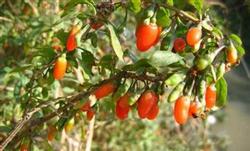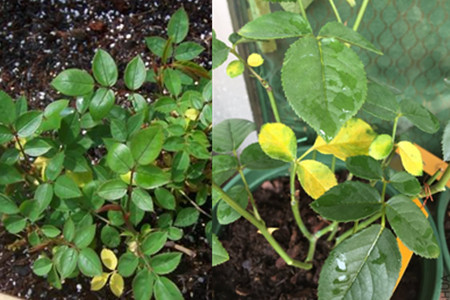Lycium barbarum Learn more about Lycium barbarum
-
Propagation and planting techniques of vegetable Lycium barbarum

Lycium barbarum is a perennial shrub of Lycium barbarum in Solanaceae, which is distributed all over the country. The plant likes light, cold and heat tolerance, drought tolerance and humidity tolerance. The suitable temperature for growth is 15: 20 ℃. The growth is slow at 10 ℃ and poor at more than 25 ℃. At present, fruit harvesting is mainly used in northern China, such as Ningxia, Gansu, Shaanxi and Shandong, while vegetable use is mainly used in southern China, such as Guangdong and Shanghai. Chinese wolfberry for vegetables has a sweet and bitter taste and unique flavor, which is not only rich in nutrition, but also has a high medicinal price.
2019-01-16 -
Medicinal value and planting techniques of Lycium barbarum

Chinese wolfberry is an important economic plant and a good product for both medicine and food. There are 7 species of Lycium barbarum, Lycium barbarum and Lycium barbarum. Among them, there are three kinds of traditional medicinal value, namely, Huangguo Lycium barbarum (Ningxia Lycium barbarum var.) and northern Lycium barbarum L.
2018-07-19 -
Production Technology of Lycium barbarum Fruit Juice Powder (Lycium barbarum Polysaccharide) and Lycium barbarum Fruit Juice Powder

1. Introduction of technology: the industrial production of Lycium barbarum L. has become a reality by using solubilization and filtration aid technology. Lycium barbarum extract has good instant solubility, crystal clear solution, no precipitation and stratification, solves the technical problems of turbidity, precipitation and stratification of Lycium barbarum juice, and improves the quality grade of the product. Using low temperature vacuum concentration and second vacuum drying technology, the product has good color, fragrance and taste, and the loss of nutrients in the processing process is very small. Enzymatic hydrolysis technology is adopted to improve the extraction efficiency, adjust the viscosity of the slurry appropriately, and ensure the product quality.
2019-01-15 -
Management techniques of Lycium barbarum for growing vegetables

Lycium barbarum is a perennial shrub of Lycium barbarum in Solanaceae, which is distributed all over the country. The plant likes light, cold and heat tolerance, drought tolerance and humidity tolerance. The suitable temperature for growth is 15: 20 ℃. The growth is slow at 10 ℃ and poor at more than 25 ℃. At present, northern China, such as Ningxia,
2020-11-08 Growing vegetables using Chinese wolfberry management technology yes Solanaceae genus -
Introduction of symptoms and control methods of powdery mildew of Lycium barbarum

Lycium barbarum powdery mildew, also known as Lycium barbarum leaf spot, is mainly harmful to leaves and fruits. The leaf infected with the disease is round to nearly round, the size is 2mm, the edge of the spot is brown, the center of the spot is gray, and the back of the leaf is often black-gray mildew. Fruit infection also produces similar symptoms.
2018-08-31 -
What is the latest origin distribution of Chinese wolfberry?

Most of the Chinese wolfberry for daily consumption and medicine is the fruit of Ningxia wolfberry. Ningxia wolfberry has the largest cultivated area in China. Ningxia wolfberry is mainly distributed in northwest China. Chinese wolfberry is mainly distributed in Northeast China, Hebei and Shanxi.
2020-11-10 The latest Chinese wolfberry origin distribution have which people daily -
Green, nutritious vegetable Lycium barbarum-Ningqi vegetable No. 1

Through the interspecific hybridization between wild Lycium barbarum and Ningxia Lycium barbarum, researchers of the Institute of Lycium barbarum, Ningxia Academy of Agriculture and Forestry, successfully selected a new vegetable variety of Lycium barbarum, "Ningqi vegetable No. 1". The project has been identified by experts organized by the Department of Science and Technology of Ningxia Hui Autonomous region. The successful cultivation of vegetable Chinese wolfberry has opened up a new way for the multi-purpose development and comprehensive utilization of Chinese wolfberry. "Ningqicai No. 1" has good production characters, large growth, wide adaptability, strong stress resistance, not easy to infect diseases and insect pests, high vegetable yield, rich nutrition and good taste.
2019-01-16 -
Shaping and pruning technique of Lycium barbarum

In order to have a high yield, Chinese wolfberry must first be cultivated into a good tree shape. Lycium barbarum has strong branching ability, luxuriant growth, and has the characteristics of blooming and fruiting twice a year. Poor management, shaping and pruning will not only affect the yield of the same year, but also make the tree senescence ahead of time. Therefore, reasonable shaping and pruning is an important measure for high and stable yield of Lycium barbarum. The main results are as follows: 1. The tree shape of Lycium barbarum should be cut into umbrella-shaped circles with three layers of fruiting branches. The Chinese wolfberry planted in the first year was topped and dried at a height of about 60cm above the ground in early spring, and 10 ~ 20cm under the cut mouth.
2019-01-15 -
Shaping and pruning of Lycium barbarum

In order to have a high yield, Chinese wolfberry must first be cultivated into a good tree shape. Lycium barbarum has strong branching ability, luxuriant growth, and has the characteristics of blooming and fruiting twice a year. Poor management, shaping and pruning will not only affect the yield of the same year, but also make the tree senescence ahead of time. Therefore, reasonable shaping and pruning is an important measure for high and stable yield of Lycium barbarum. The main results are as follows: 1. The tree shape of Lycium barbarum should be cut into umbrella-shaped circles with three layers of fruiting branches. The Lycium barbarum planted in the first year was topped and dried at a height of about 60cm above the ground in early spring, and 10 times below the cut mouth.
2019-01-15 -
Introduction to the main producing areas and varieties of Lycium barbarum

With the improvement of people's living standards, the trend of health preservation is becoming more and more popular, and Chinese wolfberry is one of the hot varieties of health food. Chinese wolfberry, also known as Chinese wolfberry, is used for both medicine and food, but the small one has a variety of health effects, and many people like to use it to make tea.
2020-11-27 Lycium barbarum main producing area and variety classification introduction with -
Can Chinese wolfberry be planted in the south?

As we all know, Chinese wolfberry is of great significance to human health. It can take care of the body and is a favorite fruit. The quality of Ningxia wolfberry in the north of China is ahead of all parts of the country and has become the representative of Chinese wolfberry. So, Chinese wolfberry can be planted in the south.
2020-11-08 Chinese wolfberry in the south can be planted we all know -
Lycium barbarum gall mite and its control

Lycium barbarum gall mite belongs to the family gall mites. In order to damage leaves, tender shoots, petals, buds and young fruits of Lycium barbarum, purple or yellow diseased galls were formed in the affected parts. Lycium barbarum gall mites overwintered as mature adult mites in the scales of winter buds or in the cortical cracks of branches. In April of the following year, adult mites moved to the new leaves of old branches to lay eggs, and after hatching, nymphs invaded plant tissues to cause galls. Gall mites climbed from galls to new shoots in mid-late May, and the first peak period of reproduction was formed in late June. By the middle of August, when the autumn shoots grow, the gall mites turn to the new shoots.
2019-01-15 -
Control methods of powdery mildew of Lycium barbarum

Control methods of powdery mildew of Lycium barbarum
2018-07-05 -
The latest control methods of powdery mildew of Lycium barbarum

Lycium barbarum powdery mildew, also known as Lycium barbarum leaf spot, is mainly harmful to leaves and fruits. The leaf infected with the disease is round to nearly round, the size is 2mm, the edge of the spot is brown, the center is grayish white, the back of the leaf is often black-gray mildew, and the fruit infection also produces similar symptoms.
2020-11-10 The latest Chinese wolfberry white powder disease prevention and control methods -
Vegetable Chinese wolfberry-Ningqi No.1

Through the interspecific hybridization between wild Lycium barbarum and Ningxia Lycium barbarum, researchers from the Institute of Lycium barbarum of Ningxia Academy of Agriculture and Forestry have successfully selected a new vegetable variety of Lycium barbarum "Ningqi No.1". The project has been identified by experts organized by Ningxia Science and Technology Department. The successful cultivation of vegetable Lycium barbarum has opened up a new way for the multi-purpose development and comprehensive utilization of Chinese wolfberry. "Ningqi No.1" has good production characters, large growth, wide adaptability, strong stress resistance, not easy to infect diseases and insect pests, high yield, rich nutrition, good taste, good cultivation and easy management.
2019-01-16 -
The latest course on cultivation techniques and methods of Lycium barbarum seedlings

Lycium barbarum is a multi-branched shrub plant of the genus Lycium in Solanaceae. it is often grown on hillsides, wastelands, hills, saline-alkali lands, roadsides and villages. Gardens can be used as hedges, stump potted plants and shrubs for soil and water conservation. Its fruit is wolfberry and Qiongzhen Ganoderma lucidum.
2020-11-10 The latest Chinese wolfberry seedlings cultivation techniques methods tutorials trees -
Cultivation techniques of Lycium barbarum in Ningxia

Chinese wolfberry is a plant of Solanaceae and Lycium barbarum, alias Chinese wolfberry vegetable, Chinese wolfberry head, etc., rich in protein, amino acids, carbohydrates, a variety of vitamins, fruit as medicine, it has the effect of nourishing yin and tonifying kidney, tonifying qi and calming mind, strengthening body, delaying aging, and can treat diabetes, chronic hepatitis, tuberculosis and other diseases. Ningxia wolfberry.
2018-07-19 -
Finding biological agents for diseases and insect pests during the growing period of Chinese wolfberry

With the birth of four kinds of compound pure biological agents prepared by the research group of "Research on Biological Control techniques of main Diseases and insect pests of Lycium barbarum" of Institute of Plant Protection of Ningxia Academy of Agricultural and Forestry Sciences, the diseases and insect pests restricting the development of Lycium barbarum industry in Ningxia have finally encountered the biggest "natural enemies". The use of this chemical will realize the biological control of diseases and insect pests in the whole growing period of Chinese wolfberry, which can not only reduce the times of control, but also improve the quality of Chinese wolfberry. Lycium barbarum is a traditional Chinese medicine grown in Ningxia, and it is also a leading industry determined by the party committee and government of the autonomous region. However, the occurrence of diseases and insect pests of Lycium barbarum is extremely complex.
2019-01-16 -
Techniques of shaping and pruning of Lycium barbarum

In order to have a high yield, Chinese wolfberry must first be cultivated into a good tree shape. Lycium barbarum has strong branching ability, luxuriant growth, and has the characteristics of blooming and fruiting twice a year. Poor management, shaping and pruning will not only affect the yield of the same year, but also make the tree senescence ahead of time. Therefore, reasonably
2020-11-08 Species Chinese wolfberry it plastic surgery pruning technology want high yield -
The causes of yellow rose leaves, diseases and insect pests are all murderers.

Rose is a very common flower and plant, its flowers are numerous and colorful, and it is very popular with people, but many people who raise rose flowers have encountered yellowing of flowers and leaves, so what are the specific reasons?
2018-12-06
